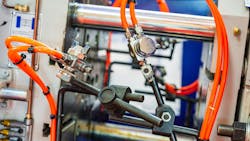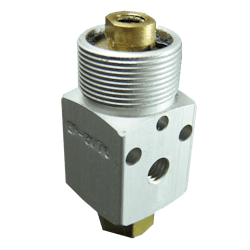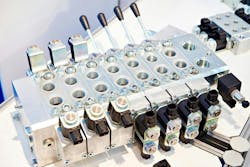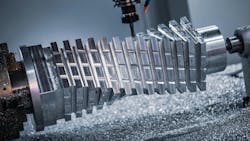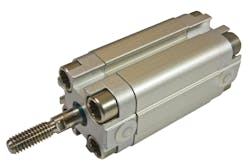Hydraulics and Pneumatics Benefit a Range of Industrial Applications
What you'll learn:
- Performance benefits hydraulics and pneumatics can provide industrial applications.
- Why fluid power technologies may be a better fit in some cases than electromechanical options.
- The industrial applications in which fluid power systems are most commonly utilized.
Industrial applications continue to rely on hydraulics and pneumatics because of the power density, durability and other performance benefits these systems can provide. These benefits, along with the many technological developments taking place in the industry, are enabling fluid power to remain a technology of choice in applications such as packaging, semiconductor production, robotics, and many more.
In this first of a three-part Q&A series, members of the fluid power industry offer their insights on what makes hydraulics and pneumatics a good fit for the industrial sector as well as the applications in which they see these systems being utilized.
Read the next two parts of this Q&A series in the following articles which examine technological capabilities desired by customers in industrial applications and future opportunities for fluid power.
Part 2: Industrial Applications Require Smart and Efficient Fluid Power Systems
Part 3: Opportunities Remain for Industrial Fluid Power Applications
Power & Motion: Are hydraulics and pneumatics still an important technology of choice in industrial applications (such as machine tools, packaging machinery, etc.)?
Andrew Aurand, Director of Sales & Marketing, Clippard: Absolutely. While other technologies have emerged, hydraulics and pneumatics remain fundamentally important and, in many cases, the superior choice for industrial automation. The core value proposition of fluid power is undeniable: it offers an unmatched combination of high power density, robustness, and cost-effectiveness.
For applications requiring immense force and power, such as stamping presses, injection molding machines, or heavy-duty machine tools, hydraulics provide a level of force in a compact package that is simply not feasible or economical with electric alternatives.
On the pneumatics side, the technology is indispensable for millions of high-speed, repetitive tasks. Think about packaging lines, assembly automation, or material handling. Pneumatics offer incredible speed, simplicity, reliability, and a lower cost per unit of force for linear motion and gripping than almost any other technology. The components are durable and can withstand harsh industrial environments — including high temperatures, washdown conditions, and dust — where more sensitive electronic components might fail.
Jacob Paso, President, Delta Motion: Fewer electric vehicles burn up because of hydraulics. Rockets are launched into space more reliably because of hydraulics. The sheet metal in your mobile phone is of higher quality because of hydraulics. And lumber is less expensive because of hydraulics.
Hydraulics are absolutely essential for industrial machines, especially where high precision, high forces and the combination of position and force control are required.
Cindy Cookson, VP & GM, Fluid Power Americas, Gates Corp.: Absolutely. Hydraulics remain the backbone of heavy industrial equipment because of their power density and efficiency. A single hydraulic pump can drive multiple actuators, which is far more cost-effective than complex electric systems. Even as electrification grows, hydraulics are still essential for medium- and heavy-duty applications like mining, grain handling, and rock crushing. At Gates, we continue to invest in fluid power solutions because they deliver reliable performance in the most demanding environments.
Michelle Gladysz, Product Line Manager – MFB Valves, Moog Industrial Group: I've been working in hydraulics for almost 25 years now and I remember even when I started that everyone said ‘hydraulics is not going to last forever, everybody wants to switch to electrical.’ But 25 years later there's still plenty of applications where it [hydraulics] really is the best choice. The level of power that you can get out of hydraulics compared to electrical, there's still a lot of benefits for a lot of different applications, so it’s certainly not going away anytime soon. [Hydraulics is] still definitely the technology of choice in a lot of areas.
Dan Detweiler, Value Added Systems and Technical Services Manager, Parker Hannifin: Yes, hydraulics and pneumatics are still relevant although more efficient designs are being requested by our customers. Force density is still a driving factor for fluid power in industrial applications. Pure electromechanical solutions still struggle to have the same power and cost ratio for the same space claim in high power machines. We have seen many attempts to displace hydraulics with electromechanical (EM) solutions that have failed because of either reliability or cost or both.
Localized power is gaining in popularity where the linear or rotary actuator has its own self-contained hydraulic power unit (HPU), moving away from a single central HPU. Another area to consider is some machines/industries will have hazards classification levels that may be challenging for EM solutions. Pneumatics provide fast actuation at a lower cost than hydraulics, and without any of the problems that oil/leakage pose to a facility.
Shalom Kundan, Division Marketing Manager, Parker Hannifin: Yes, pneumatics remains a vital technology in industrial automation. It continues to be the preferred choice where simplicity, reliability, speed, and cost-effectiveness are critical. For applications requiring repetitive motion, quick actuation, or harsh environments, pneumatics still provide advantages over electric or hydraulic alternatives.
John Fenske, Director of Marketing, Tolomatic: Absolutely. Fluid power systems continue to offer unmatched advantages in force density, speed, and simplicity. They can also be very economical, particularly if the infrastructure is in place (HPU, compressed air).
Power & Motion: Are there certain types of industrial applications where you’re seeing hydraulics and pneumatics being specified more than others? If so, which ones and what are the benefits of using fluid power in these applications?
Andrew Aurand, Clippard: Yes, we are definitely seeing certain "sweet spots" where fluid power excels. For pneumatics, our specialty at Clippard, we see significant growth and specification in:
- Medical Device and Life Sciences: This is a major growth area. The need for precise, clean, and reliable control of gases and fluids is critical. Our miniature electronic and proportional valves are used extensively in ventilators, anesthesia equipment, dialysis machines, and laboratory automation for analytical instrumentation. The benefits here are precision, repeatability, small package size, and the use of inert materials.
- Packaging and Bottling: The sheer speed and repetitive nature of these applications make pneumatics the ideal choice for actuating gates, diverters, fillers, and labelers. The components are fast, cost-effective, and easy to maintain, which is crucial for minimizing downtime in high-throughput operations.
- Semiconductor and Electronics Manufacturing: In applications like pick-and-place for delicate components or wafer handling, pneumatics (and vacuum) provide a gentle touch, high speed, and a clean method of actuation.
For hydraulics, the primary applications remain those that require extreme force and durability, such as metal forming, injection molding, heavy mobile equipment, and large-scale industrial presses.
Jacob Paso, Delta Motion: While hydraulics are specified in a vast array of applications, we see hydraulics specified especially in sawmill machinery, steel mills, metal forming such as large presses, and testing machines. Sawmill machines experience high shock and vibration and require high speeds and precision, all of which hydraulics excel in. The energy density of hydraulics allows the machine itself to be smaller. Large presses require the load capacity of hydraulics, as well as precise position and force control.
The high accuracy achieved by pancake hydraulic cylinders has led battery film rolling presses to achieve higher accuracy than with electric, resulting in fewer hot spots in the film, with corresponding fewer battery failures and fires. Testing machines may require millions of cycles, for which the long cycle life of hydraulics is well suited, or testing may require precisely controlled large forces, also served exceptionally well by hydraulics. Similarly, steel manufacturing and metal forming require heavy forces and accurate control.
Cindy Cookson, Gates Corp.: We continue to see hydraulics specified in the heavy-duty and high-articulation applications. Think boom arms, lifting equipment, forestry, or CNC and injection molding machinery. In these spaces, flexible hoses are critical for tight routing and constant movement. Gates’ MXT and MXG hoses, which are 40% more flexible than legacy hoses, are designed precisely for these kinds of applications where reliability and ergonomics matter most.
Michelle Gladysz, Moog Industrial Group: We certainly have a lot of applications in the power generation market still. We've seen, especially globally, that there's more demand for our power generation systems, which include hydraulic actuators and valves on the turbines. As countries like China are continuing to grow and expand, there's more demand for those power generation facilities, and the power and efficiency of the hydraulic systems to control those efficiently really can't be matched by electric systems. There's still a strong demand in the U.S., but even more globally, and those power generation facilities still require hydraulics.
Another example is the plastics industry. A lot of injection molding equipment relies on hydraulics as well. They require a consistent, very stable force; hydraulic controls in our valves really provide that level of precision that is hard to achieve with electrical systems.
We have a lot of pneumatic applications in the semiconductor industry these days, that certainly is growing. The precision and control that you can get from a pneumatic device in things like wafer handling or assembly in semiconductors really is difficult to get with any other technology. There are some other niche applications; one of my favorites uses our smaller valves in subsea applications, in oil and gas exploration robotics undersea. It's really amazing that what we can do in a very small package, when it's required for those special applications.
Dan Detweiler, Parker Hannifin: For hydraulics, any applications that require power density and large forces are still predominantly staying with hydraulics over other options. For example, metal forming still needs the high forces of hydraulics for product manufacturing. EM products have difficulty matching the force and speed hydraulic systems can achieve. Hydraulics continues to be the preferred solution on drill rigs, high tonnage presses, shredders, material handing processes and renewable technologies such as wind and wave turbines. Large chemical plants use hydraulics for handling vats, mixing, pouring and moving lids. Paper mills use hydraulics for moving rolls, forming the paper, loading and unloading rolls. Other applications take advantage of hydraulics’ power density combined with smooth motion combined with the hydraulic oil’s ability to dissipate heat. For example, automotive suspension springs are formed in hot environments and prestressed by hydraulics.
Pneumatics is still the primary solution for high duty cycle, low force, and fast cycle time applications where an electromechanical solution would be challenged to match it for life expectancy. Pneumatics tends to find a home in packaging and light material handling processes. These are applications where higher speed actuation is required, sometimes with moderate forces precision. Fluid power is still the preferred solution in extreme environments, including high and low temperatures, high humidity, and exposure to salt water.
Failure mode comparisons between hydraulics systems versus electromechanical systems are another factor. Hydraulics systems are better position to allow for continued control when a machine shuts down unexpectedly. With many EM systems, the actuators will simply stop in place. With hydraulics, you have the opportunity to have back up accumulators and valve technology to allow your machine to go into a safe mode without backup power.
Shalom Kundan, Parker Hannifin: Pneumatics are heavily specified in various industrial automation end-markets including packaging machinery, food and beverage, life sciences, and dry material handling systems, robotics, warehouse automation, machine building, palletizing, and various other upstream and downstream processes.
Benefits include clean operation (no risk of oil contamination), lightweight components, and the ability to deliver high-speed cycling at a relatively low cost. Safety is also a factor as pneumatic systems are generally less hazardous than electrical alternatives in washdown or explosive environments.
John Fenske, Tolomatic: We see pneumatics widely specified for high speed, repetitive tasks like packaging lines, food processing, and material handling. While hydraulics are prevalent in applications requiring extremely high force and resilience in harsh conditions such as metal forming & fabrication and construction & mining equipment.
About the Author
Sara Jensen
Executive Editor, Power & Motion
Sara Jensen is executive editor of Power & Motion, directing expanded coverage into the modern fluid power space, as well as mechatronic and smart technologies. She has over 15 years of publishing experience. Prior to Power & Motion she spent 11 years with a trade publication for engineers of heavy-duty equipment, the last 3 of which were as the editor and brand lead. Over the course of her time in the B2B industry, Sara has gained an extensive knowledge of various heavy-duty equipment industries — including construction, agriculture, mining and on-road trucks —along with the systems and market trends which impact them such as fluid power and electronic motion control technologies.
You can follow Sara and Power & Motion via the following social media handles:
X (formerly Twitter): @TechnlgyEditor and @PowerMotionTech
LinkedIn: @SaraJensen and @Power&Motion
Facebook: @PowerMotionTech

Leaders relevant to this article:
